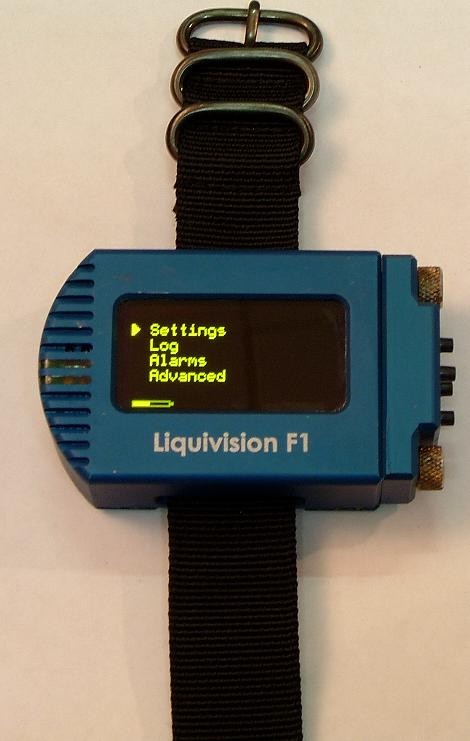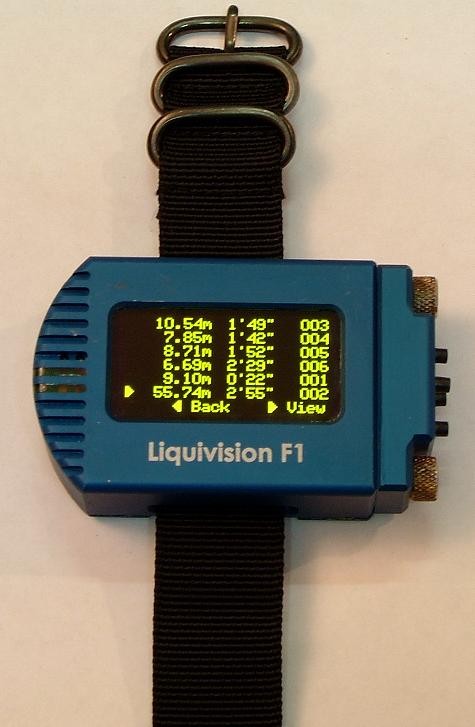You and your freediving computer: true love or a marriage of convenience? Sure, it works, more or less, but isn’t it true that sometimes, perhaps when you’ve had a few beers and glance it from the corner of your eye, you wonder whether you couldn’t do better if you had it to do all over again ?
Perhaps sometimes at depth the liquid crystal display characters are a little hard to read unless you contort yourself into exactly the right position – and not neccesarily one which is well streamlined. The user interface and menu system on some popular models jack my heart rate up to triple digits, designed, apparently, by sadistic uber nerds for the sole purpose of defeating hypoxic brains.
And then, there’s the battery. It dies, and all too soon. When it does one can either change it ( and incur the considerable risk of failure ) or follow instructions and ship it back to the factory for service. Pain, money or both.
Eric Fattah saw opportunity where others saw a list of niggling complaints.
"There’s no doubt that freediving computers have gotten better", he conceded."The best ones are pretty good, in fact, with no fatal flaws. It’s just that the little things, in the aggregate, add up to overall dissatisfaction."
Eric’s a former world record holder in the constant ballast discipline. His self-discipline, meticulousness and systematic approach to everything he does are something of a legend. He compiled the exhaustive list of the faults apparent in commercially available dive computers and set out to design them away. The result is the F1 : arguably the Ultimate Freedive Computer.

"Display visiblity and the battery problem were obvious", Fattah recalls. "Less so are things like a too-slow sampling rate, which can make your computer understate the depth you reach on a dive and omit critical detail from recorded dive profiles. For example, arm strokes in the no-fins disciplines. Some of the available computers made reviewing the stored data a problem, too. Most normal people find getting the data to the PC somewhere between frustrating and impossible. Assuming the computer remembers the data. Most of them had too little memory, so old dives get forgotten."
All true, now that you mention it. How did I come to accept all those flaws?
"The F1", declared Eric, "Solves all of these problems."
Eric Fattah also wanted a more rugged instrument, one whose casing and lens wouldn’t be quickly scratched to ruin in the less-than-delicate freediving environment.
The FI design concept matured in September, 2004. The prototype was completed six months later, and in April 2006 rode with Mandy-Rae Cruickshank on her World Record 50m no-fins constant ballast dive.
Eric Fattah: " In the fall of 2005 the F1 passed its real-world final exam. Henry Kaiser did 40 scuba dives with an F1 in Antarctica, in -40 C air and -2 C water." The F1 took it in stride.
The first production units were brought to market in December, 2006 by Liquivision, the company Eric Fattah founded to manufacture his revolutionary fluid goggles. According to Fattah the F1 computer now has over 3 engineering man-years and $400,000 invested in its research and development.
The investment shows. I tried the F1 last month in the cold, dark waters of Catalina Island. The first thing that struck me was the stark, functional appearance of the device. The F1 does not pose as costume jewelry. I had a tiny bit of trouble threading the limp wrist strap and getting the buckle tongue through a hole, especially in contrast to the semi-rigid plastic straps seen on other models. That, however, is the only point the F1 concedes to any rival.
The first day I dived the F1 at Catalina the visibility was on the order of 5m/16ft, meaning it was pitch black water from 20m /66ft on down. The F1 display was simply brilliant. I didn’t quite get the computer down to its rated depth of 275m/902ft (I was having an off day) but on the 35m/115ft bottom the OLED characters were crisp, bright and easily readable from any angle. Even to my aging, presbyopic eyes. I wish my morning newspaper were so readable.

And what a readout! The F1 display provides an array of information that yields a complete picture of the dive and the dive environment. There’s a lot of info there, but the ergonomics of the display layout and the OLED presentation make it effortless to absorb it all.
The computer’s accuracy and consistency are, according to Liquivision, unmatched by competitors’ technology. Fattah’s system architecture affords robust adaptation to variations in salinity, temperature, altitude and meteorological-scale barometric pressure. Fed by samples taken at the rate of 4/second, the F1’s depth measurements and logging are ridiculously precise.
Ridiculous – unless one is serious about freediving. The designer’s accomplishments as a freediver are due in no small measure to his disciplined and systematic approaches to training and competition. These same qualities are apparent in the F1’s design and assembly. An F1 is sort of like canned Eric Fattah – a tireless coach and trainer who never forgets and never makes a mistake. Even at US$ 749 ( a discounted introductory offer expiring August 17th) perfection doesn’t come cheap, but 40 years after buying an F1, when it’s finally time to change the rechargable lithium battery, I’m guessing the owner will agree it was worth it.
For more information and to purchase an F1 – head over to the Liquivision Website
